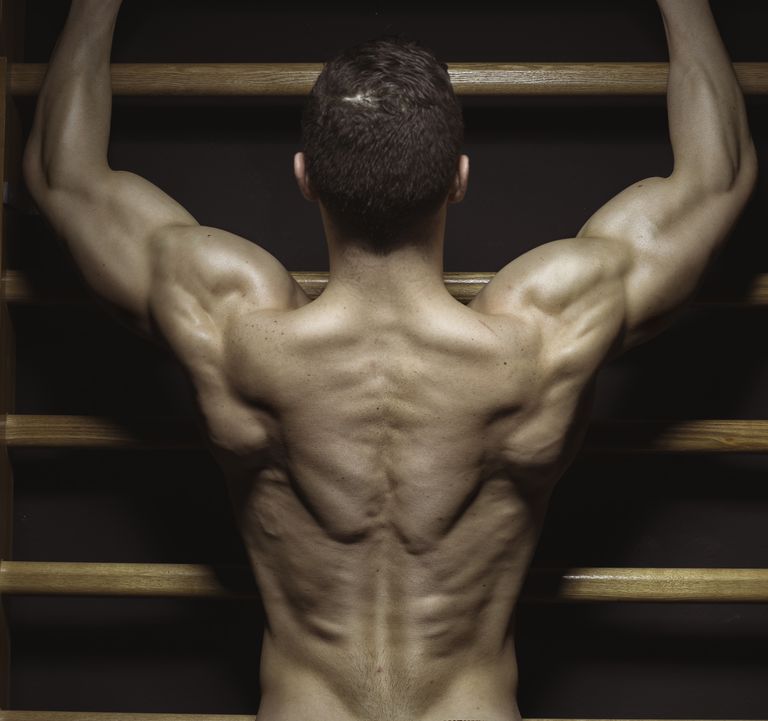
If you want your back to stand out, you’re going to have to become a trap king.
Well-developed traps (aka the trapezius, or trapezoid) can be the key to a well-developed, awe-inspiring back. The long, triangle-shaped muscle takes up a ton of real estate on the top half of your back, so you can seriously change the topography of your upper body by building it up.
Besides adding size to your back and shoulders, you’ll also improve strength in nearly every upper-body lift — traps are the key to scapular and spinal movement, so everything from shrugging your shoulders to supporting your arms stems from the muscle.
Start now, with these 13 great traps exercises.
Bent Over Y
The bent over Y is a simple move that can be used as a warmup sans weight, or you can use light dumbbells to work your lower traps. Keep the weight light, though — you might be surprised at how hard the Y can be.
DO IT: Stand with your feet shoulder-width apart, holding light dumbbells with your thumbs facing up. Hinge at the hip to assume a bent over position. Raise your arms in front of you forming the shape of the letter Y, holding the position for a beat. slowly return to the starting position.
Pullup Shrug
This move won’t just build your traps — it’ll also help you hone your pullup form. You’ll also work your lats, so you won’t just be isolating one muscle.
DO IT: Hang from a pullup bar, keeping your spine aligned and core tight. Pull your shoulders back and down to extend your head and neck upward. Hold for a count, then lower yourself back into the starting position.
Barbell Shrug
The barbell shrug is the king of all trap-building exercises, according to Tyler English, author of the Men’s Health Natural Bodybuilding Bible.
It targets the upper portion of your traps, which are responsible for lifting your shoulder blades.
DO IT: Grab a barbell with an overhand grip that’s just beyond shoulder-width apart, and let the bar hang at arm’s length in front of your waist. Keeping your back naturally arched, lean forward at your hip about 10 degrees.
Bend your knees slightly. Now shrug your shoulders toward your ears as high as you can. Your arms should be straight. Pause, then reverse the movement back to the starting position.
Dumbbell Shrug
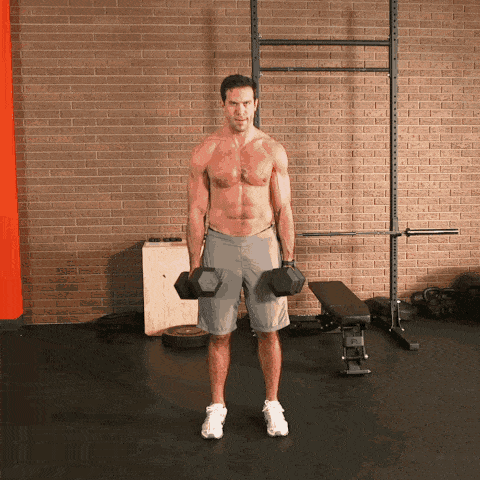

Men's Health
Compared to the barbell shrug, the dumbbell shrug places less stress on your shoulder joints.
That’s because your shoulders don’t have to rotate to hold the bar. This keeps them more stable as you perform the movement.
DO IT: Grab a pair of dumbbells and let them hang at arm’s length next to your sides, your palms facing each other. Shrug your shoulders as high as you can.
Imagine that you’re trying to touch your shoulders to your ears without moving any other parts of your body. Pause in the up position, then slowly lower the weights back to the start.
Incline Dumbbell Shrug
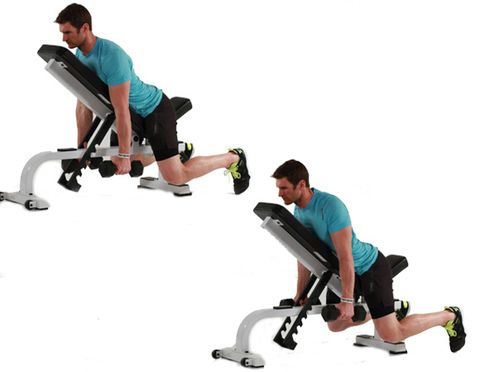
Placing your body on a low incline bench helps targets your often-neglected lower traps, said English.
The lower trapezius—responsible for pulling your shoulder blades down—is often ignored, leaving the muscle weak. This can lead to poor posture and make you more likely to fall victim to injuries such as shoulder impingement.
DO IT: Grab a pair of dumbbells and lie chest-down on a 45-degree incline bench.
Let your arms hang straight down, palms facing each other. Now shrug your shoulders up while pulling your shoulder blades together. Pause, and then reverse the movement.
Dumbbell Jump Shrug
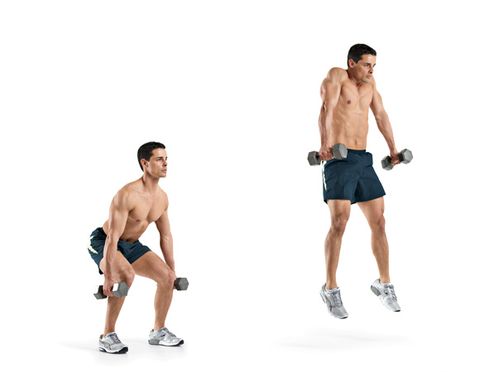
The dumbbell jump shrug hits the fast-twitch muscle fibers—the ones with the greatest potential for size and strength—of your traps and calves, English said.
The explosive movement adds power to your training program. Your goal should be to perform each rep as quickly as possible, while maintaining control of the weight at all times.
DO IT: Grab a pair of dumbbells and bend at your hips and knees. Let the weights hang at arm’s length just below your knees, your palms facing your sides. Don’t round your lower back.
Simultaneously thrust your hips forward, shrug your shoulders forcefully, and jump as high as you can. Land as softly as possible, and reset.
Barbell Behind-the-Back Shrug
This movement targets your upper traps, middle traps, levator scapulae—the rope like muscle that runs down the back of your neck, said English.
When doing this movement, don’t stick your head forward or downward. This can increase your risk of injury and prevent your traps from fully activating.
DO IT: This exercise is the same as a barbell shrug, except you’re holding the weight behind your body.
Grab the bar with an overhand grip so your palms are facing away from you, and your hands are shoulder-width apart.
Let the bar hang at arm’s length at your glutes, and then shrug your shoulders toward your ears as high as you can. Pause, then reverse the movement.
Barbell Row
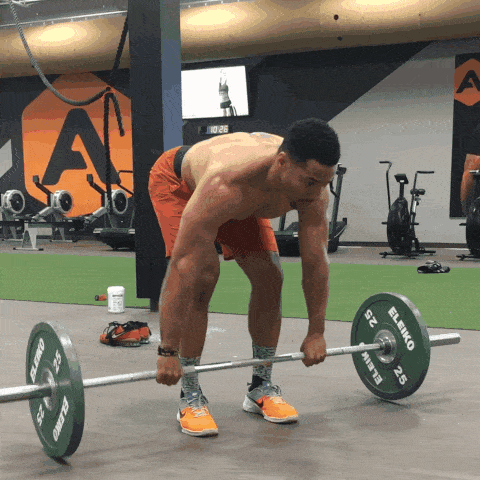
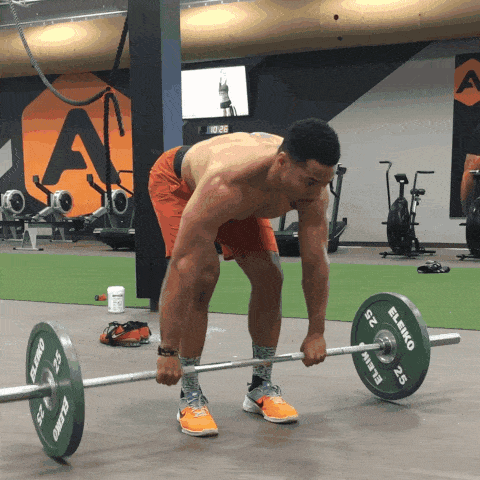
Men's Health
Rowing exercises target your middle and lower traps and rhomboids, muscles that help keep your shoulder blades from moving as you lift a weight.
That’s important because unstable shoulders can limit your strength in exercises for your chest and your arms. Your upper traps, rear deltoids, and rotator cuff muscles will also assist in the rowing movement.
DO IT: Grab the barbell with an overhand grip that’s just beyond shoulder width, and hold it at arm’s length. Bend at your hips and knees and lower your torso until it’s almost parallel to the floor. Keep your back naturally arched.
Pull the bar to your upper abs and squeeze your shoulder blades toward each other. Pause, then slowly lower the bar back to the starting position.
Dumbbell Lateral Raise
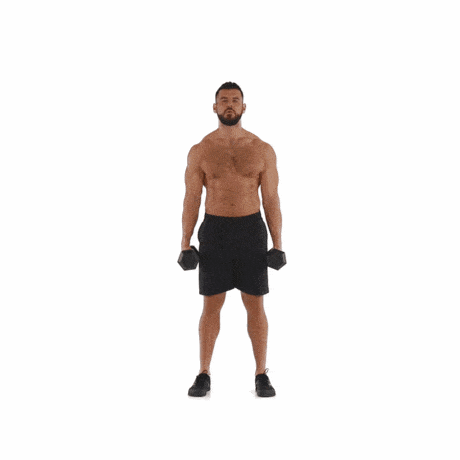

Men's Health
Your middle deltoid may be the hardest working muscle during this movement, but your upper traps are working, too. They assist in raising the weight and act as stabilizers.
Don’t rotate your upper arms inward in the up position. (Picture pouring out a pitcher of beer.) It can lead to shoulder impingement. Keep your palms facing forward and the weights straight up and down.
DO IT: Grab a pair of dumbbells and let them hang at arm’s length next to your sides. Stand tall, with your feet shoulder-width apart.
Turn your arms so that your palms are facing forward, and bend your elbows slightly.
Without changing the bend in your elbows, raise your arms straight out to your sides until they’re at shoulder level. Your arms should form a T with your body. Pause for 1 second at the top of the movement, then slowly lower the weights back to the starting position.
Overhead Barbell Shrug
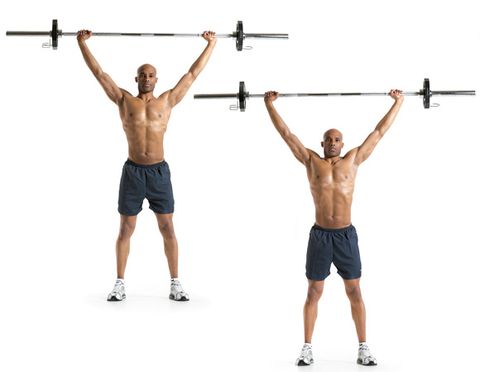
Holding the weight above your head as you shrug works your upper traps. It also reduces the emphasis on your levator scapulae—the rope like muscle that runs down the back of your neck and is frequently overused compared to the upper traps.
Since these muscles are often imbalanced, adding the overhead barbell shrug to your routine can lead to better posture.
DO IT: Hold a barbell above your head with an underhand grip that’s about twice shoulder width. You arms should be completely straight, and your feet shoulder be shoulder-width apart.
Lock your elbows and keep them that way. Shrug your shoulders, trying to raise the tops of your shoulders as close to your ears as possible.
Pause, then reverse the movement back to the starting position.
Snatch-Grip Barbell High Pull

When targeting your traps, skip the upright row and do the high pull instead. About two-thirds of men are at high risk for shoulder impingement when performing the upright row.
This is a painful condition in which the muscles or tendons of your rotator cuff become entrapped in your shoulder joint. It most often occurs when your upper arms are simultaneously at shoulder level or high and rotated inward—the exact position they’re in at the top of the upright row—with a heavy load.
The movement relies mostly on your deltoids to move the weight, with your traps being the secondary focus, English explained.
The high pull, however, is a fast power movement that relies on the traps, mid back, rhomboids, deltoids, hamstrings, glutes, and lower back to move the weight, English says.
“The high pull brings much more power and lower-body muscles into the movement, whereas the upright row is a slow ‘grinding’ movement,” he said.
So why not use a standard grip? “The snatch grip—a wide grip that’s about twice shoulder-width—puts less demand on the deltoids, and greater demand on the traps than a narrower hand position,” said English.
DO IT: Load the barbell with a light weight. Grab the bar with a wide overhand grip and let it hang at arm’s length in front of your body. Your hands should be a few inches from the weight plates. Bend at your hips and knees to squat down. Your lower back should be naturally arched.
Pull the bar as high as you can by explosively standing up as you bend your elbows and raise your upper arms. You should rise up on you toes. Reverse the movement to return to the starting position.
Dumbbell Overhead Carry
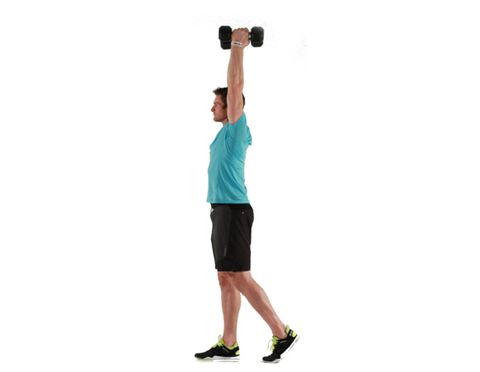
In order to keep the weights from moving as you walk, your entire trapezius muscle must be turned on to manage the load overhead, said English.
Even though your lower body is moving, your upper body is performing an isometric hold. That means you’re increasing the trap’s time under tension, spurring muscle growth.
DO IT: Grab a pair of dumbbells and press them over your head, palms facing each other. Your upper arms should be next to your ears. Walk forward.
Scaption
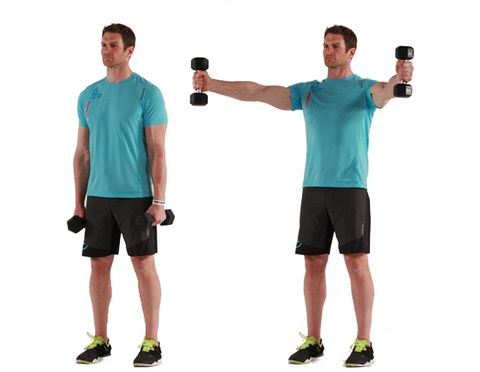
While this move primarily hits your front deltoids, rotator cuff, and serratus anterior, your lower traps and rhomboids also aid in lifting the weight.
This helps balance the muscles that rotate your shoulder blades. Adding this movement to your upper-body routine will help build stronger, healthier shoulders and a better posture, says English.
DO IT: Standing with your feet shoulder-width apart, hold a pair of dumbbells at arm’s length next to your sides. Your palms should be facing each other and your elbows slightly bent. Stand as tall as you can.
Without changing the bend in your elbows, raise your arms at a 30-degree angle to your body (so that they form a Y) until they’re at shoulder level. The thumb sides of both hands should be facing up.
Pause, then slowly lower the weights back to the starting position.
Source: Read Full Article
